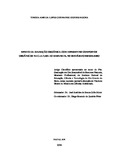Efeito da adubação orgânica com diferentes compostos orgânicos na cultura do Rabanete, no Semiárido Brasileiro

Visualizar/
Data
2018-05-25Autor
Rocha, Tereza Amelia Lopes Cizenando Guedes
http://lattes.cnpq.br/8144135426766120
Metadado
Mostrar registro completoResumo
The use of mineral fertilizers is a widely used practice in agriculture to supply the need for nutrients from crops, however, the possibility of supplying these nutrients through organic sources has been an option that gradually gains space, mainly by the paradigm shift following a view of healthier food and the sustainability of natural resources. The aim of this study was to evaluate the effect of organic fertilization with different organic compounds on the radish crop in the Brazilian semiarid region. For this, the study was performed by means of an experiment installed at the IFRN, Ipanguaçu Campus, using the radish Crimson Giant cultivar planted directly at a spacing of 0.20 m x 0.08 m. The experimental design was a randomized complete block design with five treatments and four replications. The following variables were analyzed: leaf number, root diameter, fresh shoot mass, commercial root fresh mass, total productivity, commercial productivity and percentage of cracked and / or isoporate roots. The results indicate that radishes fertilized with organic compounds from exclusively vegetable residues and sheep and cattle manure showed the most promising for organic fertilization of the radish, although they did not differ statistically from the others. However, organic compost from sheep manure is the most promising for organic fertilization in radish cultivation, providing significant labor savings for its distribution and the cost of producing this compost.



